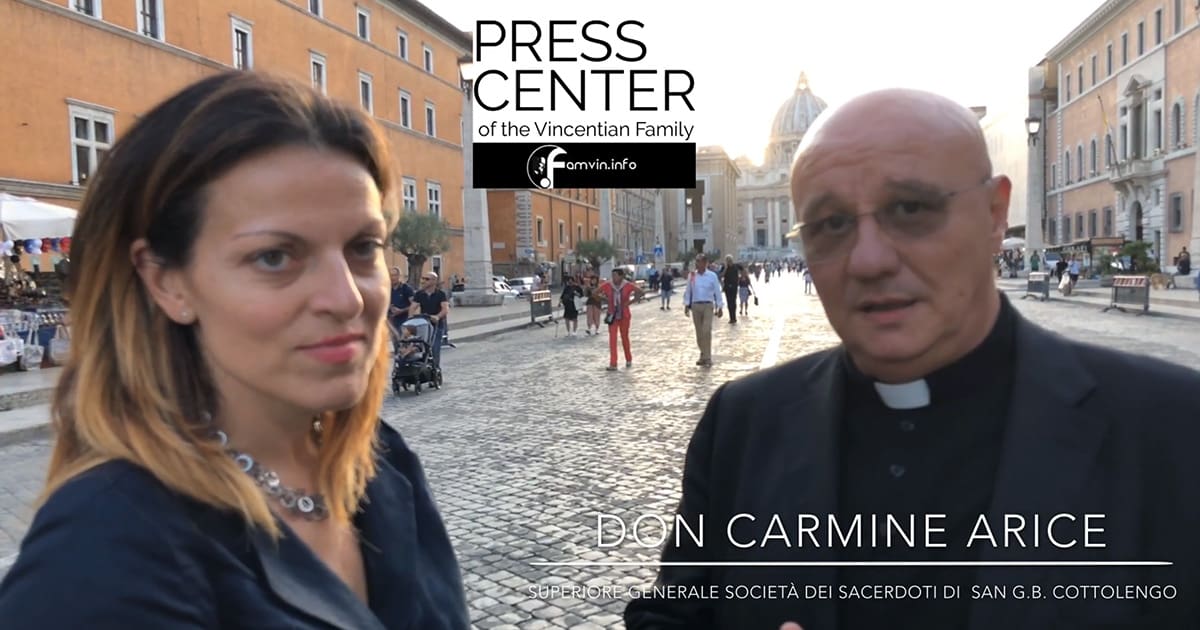Interview With Father Carmine Arice, General Superior of the Cottolenghina Family and the Little House of Divine Providence
In January 2020, Rome will host a meeting of the Superiors General and Presidents of the Vincentian Family. We continue this series of posts to deepen our knowledge of the many Vincentian Branches. Here we interview Father Carmine Arice, General Superior of Cottolenghina Family and Small House of Divine Providence.
How and when did your foundation take place?
We have a specific foundation date, September 2, 1827. It was on that day that Saint Giuseppe Benedetto Cottolengo helped a pregnant woman on her journey from Milan to Lyon. That woman died before his very eyes. After the woman had given birth (to a still born child), Giuseppe, as the priest from Turin, he had been to administer the sacraments. The woman died and left her husband to care for three children. At that time Father Collolengo asked: how can one believe in Divine Providence when such things occur? He resolved a crisis that he had experienced for some two years and stated: I now hand over me life so that similar situations will not occur … He founded a house of Divine Providence which took in infirm individuals who were not welcomed in other hospital in Turin. He began to minister with lay volunteers but very soon established a religious congregation of Sisters and then one of Brothers and priests (and this included contemplatives). His work is a holistic work and the member live within this charismatic community the Little House of Divine Providence … and will encounter people living in accord with different vocations. Over time, this religious family has branched out into a community of lay brothers, men and women religious, contemplative sisters/priests and sisters/priests involved in various apostolic ministries. The number of lay collaborators is increasing and this tree, grafted onto the Vincentian tree, has spread throughout the world: Italy, India, Tanzania, Jenya, Ethiopia, Ecuador, United States.
How does your Foundation reflect the Vincentian charism?
I do not believe that the Cottolengo movement can be understood apart from the perspective of Vincentian spirituality on whose tree we have been grafted. Two specific events. When Giuseppe was in the midst of crisis (a crisis that resulted not from his vocational option but from the state of the world in which he exercised his priestly ministry), he was given a life of Vincent de Paul to read. Upon receiving that book, he was speechless. Nevertheless, his superior stated: take this book and read it so that when you come to the table you have something to say. Giuseppe was a very joyful man and his process of self-reflection had an impact on everyone around me. It was the life of Saint Vincent that illuminated the event of September 2 (which was previously spoken about) and that revealed to him the manner in which his ministry was to become that being a servant of the poor, that is, to give witness to God’s love for those persons most vulnerable and excluded from participation in society. Today, Pope Francis would refer to such as situations as the existential peripheries and the victims of a throw-away culture. It should also be noted that all the Congregations that Giuseppe established were placed under the protections of Saint Vincent de Paul. The full name of the work was: The Little House of Divine Providence under the auspices of Saint Vincent de Paul. The groups of religious women that he established are called Vincenzine (Vincentians). The name of the religious women reveals that lifestyle that he wanted the Sisters to adopt, that is, they are to be servants of the poor in the manner as taught by Saint Vincent. The writings of Father Giuseppe are essentially Vincentian literature.
How are you preparing for the meeting of the leaders of the Vincentian Family, scheduled for January 2020, in Rome?
First of all, it is with great joy that we are preparing for this event. This initiative has filled us with much joy, and I hope that this is not an isolated event. I believe that just as Father Cottolengo enlightened his life with the Vincentian charism so also today in union with the different religious groups of the Vincentian Family (each one of which will emphasize some aspects of this charism) I believe that something new will emerge. Pope Francis addressed the participants of the General Chapter of the Schönstatt Fathers and stated: You know that a charism is not an exhibit from a museum, which stands untouched in a display case, to be contemplated and nothing more. Fidelity to the charism, keeping it pure, in no way means enclosing it in a sealed bottle, as if it were distilled water, to prevent it from becoming contaminated by the outside. No, a charism is not preserved by keeping it aside; it must be opened and allowed to go out, so it may come into contact with reality, with people, with their anxieties and their problems. I hope that this gathering, in addition to being an opportunity to know different realities, will enable us to understand how the Vincentian charisms (using the plural I mean, the charisms born from the insights of Vincent de Paul) can become ever more actual and prophetic as occurred during the time of Vincent and Father Cottolengo. Otherwise we simply erect a monument to the fallen, that is, we look at the past without any prophetic proclamation for today. This is a great challenge. Yes, it is important to share what we are doing but it is equally important to ask ourselves what we can do together to transform this world, which continues to produce many victims of the “throw-away” culture. There is where I see the importance of our unity and the relevance of our charism.
Translated: Charles T. Plock, CM
Eastern Province, USA







0 Comments